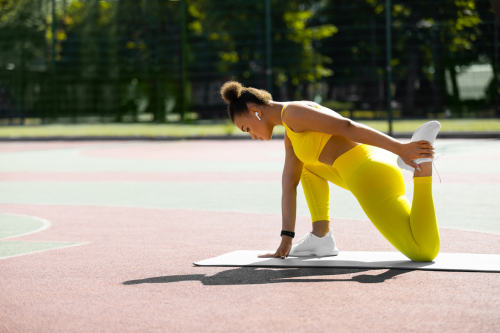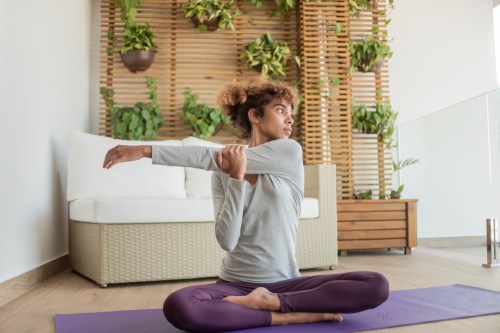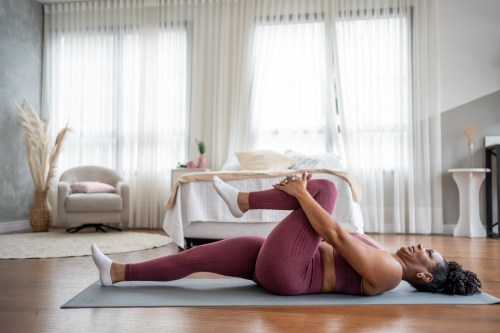Is It Possible to Stretch *Too* Much? How to Tell If You’re Overstretching
Wondering if you can stretch too much? Introducing overstretching: If you’re sore after a stretch sesh, you might have gone too far.

There’s a piece of advice we get a lot. You’ll hear it before workouts, during cooldowns, on rest days, when you’re sore, or even when you’re having trouble sleeping: Stretch! And indeed, it’s not a good thing to never stretch. But is overstretching a thing, and can you stretch too much?
Experts in This Article
vice president of education at StretchLab
physical therapist and co-founder of Body Evolved, a stretching and physical therapy studio in New York City
physical therapist and owner of Empower Physical Therapy and Performance in Massachusetts
board-certified orthopedic surgeon and chief medical officer of Stretch*d
Well, yes. An overly enthusiastic approach can lead to overstretching. “A lot of people assume that the solution to every problem or ache and pain they have is stretching,” says Haley Harrison, DPT, OCS, CSCS, owner of Empower Physical Therapy and Performance in Massachusetts. “And stretching can help. But it’s definitely not the end-all, be-all, or the answer to every problem.”
As healthy as stretching can be for our bodies, this good habit can backfire if you take it too far. “You can absolutely overstretch if you don’t know the proper method to do it, and you take a muscle past where it needs to go,” says board-certified orthopedic surgeon Pamela Mehta, MD, chief medical officer of Stretch*d, an assisted stretching studio.
If you’re worried you might be stretching too much or too hard, here’s what you need to know about how to avoid overstretching and what you should be doing instead.
What counts as “overstretching”?
The term overstretching can refer to a couple different stretching mistakes. We can overstretch a muscle when we push it past a healthy length, placing strain on that tissue or one of the joints it’s attached to.
“Overstretching typically means the length of the tissue is greater than ones ability to control said length,” says Corinne Croce, DPT, physical therapist and co-founder of Body Evolved. “It can also mean a muscle is stretched past its point of natural elasticity and healthy tissue length.” She says this can happen more frequently in those with hypermobile joints, which have really loose ligaments that allow the joint to move farther than it needs to.
Overstretching could also be about spending too much time stretching, like if you overdo it with too much Pilates or yoga.
Of course, “too much” is a subjective phrase. If you’re someone who’s naturally mobile, you probably don’t need to stretch all that much, according to Harrison. (For instance, as a former dancer who used to stretch constantly, she says today she’ll do mobility work as a warmup to hit her end ranges of motion, but no longer works to increase her flexibility.)
On the other hand, if you’re naturally tight, you’ll benefit from stretching more often to balance out your body (but try not to stretch cold muscles).
What happens when you overstretch
Proper stretching will bring blood flow to the muscles, lengthening them without irritating them. But when you push your body into a range of motion it’s not prepared to handle, or hold it for too long, you can cause the same kinds of microtears in the muscles that can happen after a tough workout.
“It’s tissue tolerance,” says Harrison. “It’s the same as if we [suddenly] do a lot of strength work that maybe we hadn’t been doing [before].”
When our body works to repair those tears, says Dr. Mehta, it can create inflammation that leads to aches and soreness the next day.
“Oftentimes people won’t even recognize why they feel that way—they may have felt like they over worked out when they actually might have overstretched,” says Dr. Mehta. (Though, know that if you’re sore after a yoga class, that could be from the strength challenge of hitting and holding the poses, not necessarily from the stretches.)
Although overstretching is unlikely to lead to injury—unless you totally ignore all your body’s pain signals—Harrison says you could irritate an existing issue if you’re stretching near a joint that is already hypermobile.
Where overstretching is most common
People are most likely to overdo it with their hamstrings. “I find that a lot of folks who come in with pain in the back of their thigh automatically assume that their hamstring is tight, and they do tons of static forward folds,” she says. But that pain could actually stem from the back or the sciatic nerve—in which case, stretching could make the problem worse, she says.
Dr. Mehta adds that it’s easy to overstretch the hamstrings because they’re bigger muscles, so you can push them a little further. But, she adds, “as an orthopedic surgeon, I’m coaching my patients that they really need to pay attention to the smaller muscles, like the rotator cuff.” Those smaller muscles are more likely to get overlooked and need attention.
Symptoms of overstretching
While you should feel a bit of tension in the muscle when you stretch, pain is a sign that you’ve gone too far. “I think a lot of people are like, ‘go big or go home’ with everything in the gym, and stretching can be one of those things where they feel like they need to have this very intense sensation, but that’s not the case,” says Harrison.
Austin Martinez, MS, CSCS, ATC, vice president of training and experience at StretchLab, previously told Well+Good that some common signs you might be pushing too deep include holding your breath, squirming, nerve pain, sharp pains in the muscle, or shaking. Think about your stretch intensity level on a scale of 0 (no stretch) to 10 (pain).
“For larger muscles, such as hamstrings, quadriceps, and glutes, aim for a 5 to 7 stretch,” he says. “For small muscles, such as wrists and neck, aim for a 3 to 5 stretch. Your aiming point on the scale will start to lower as your body adapts to stretching.”
You also may be overstretching if a certain move makes you feel vulnerable, Croce says. If you feel like if you take one wrong step or movement that something will go wrong, you’re likely stretching too far.
As for how long to hold a static stretch, Harrison says it only takes 30 to 60 seconds to get that muscle-lengthening effect. She points out that there is some research to suggest that older adults can benefit from holding stretches on the longer side of that range, since our muscles become less elastic over time. But holding for much longer than a minute is unlikely to offer additional benefits.
How to overcome an overstretching injury
If your muscles are screaming the day after stretching too much, you might be tempted to stay in bed. But it’s actually more helpful to get moving—just be gentle with yourself.
“I wouldn’t do the same stretches again, and I wouldn’t do the hardest workout you’ve ever done, but [I’d suggest] some general walking and some light strength training,” suggests Harrison.
Dr. Mehta also recommends doing some easy dynamic stretches where you only hold for a few seconds at most. “Motion is the lotion for the joints and for the muscles,” she says. “The last thing you want to do is be sedentary. That will make everything much more stiff.” She adds that using some ice and heat can also help your muscles feel better faster.
A better approach to stretching
Rather than spending minutes at a time on certain stretches, or pushing your body into positions that don’t feel good, Dr. Harrison says it’s essential to balance out your time at the gym.
“If you’re just stretching and stretching, but never strengthening into that new range of motion that you’ve acquired, it’s unlikely that that range of motion will be maintained over the long term,” she says. She uses the hamstrings as an example: After all those forward folds that you practice to touch your toes, try doing some Romanian deadlifts or deadlifts from the floor so that you contract the hamstring in that lengthened position.
Mobility and stability drills can also increase control over your flexibility. Croce says controlled articular rotations (CARS) are excellent drills for mobility.
If you’re not sure how to start an appropriate stretching routine, working with a personal trainer or visiting a stretching studio can help you find some of the best stretches for your body (and give you a sense of what an appropriate stretch really feels like).
“Listen to your body, and feel where you’re hitting that resistance,” says Dr. Mehta. When your muscles yell “enough!” back off.
Sign Up for Our Daily Newsletter
Get all the latest in wellness, trends, food, fitness, beauty, and more delivered right to your inbox.
Got it, you've been added to our email list.










